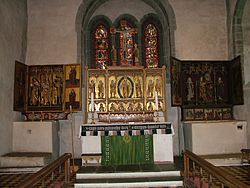| Trondenes Church | |
|---|---|
| Trondenes kirke | |
 View of the church | |
 | |
| 68°49′19″N16°33′46″E / 68.82193339°N 16.5628402°E | |
| Location | Harstad Municipality, Troms |
| Country | Norway |
| Denomination | Church of Norway |
| Previous denomination | Catholic Church |
| Churchmanship | Evangelical Lutheran |
| History | |
| Status | Parish church |
| Founded | 11th century |
| Consecrated | c. 1435 |
| Architecture | |
| Functional status | Active |
| Architectural type | Long church |
| Completed | c. 1435 |
| Specifications | |
| Capacity | 300 |
| Materials | Stone |
| Administration | |
| Diocese | Nord-Hålogaland |
| Deanery | Trondenes prosti |
| Parish | Trondenes |
| Type | Church |
| Status | Automatically protected |
| ID | 85673 |
Trondenes Church (Norwegian : Trondenes kirke) is the northernmost medieval stone church of Norway and the world's northernmost surviving medieval building. It is a parish church of the Church of Norway in Harstad Municipality in Troms county, Norway. It is located on the northern edge of the town of Harstad. It is the main church for the Trondenes parish which is part of the Trondenes prosti (deanery) in the Diocese of Nord-Hålogaland. The white, stone church was built in a long church style around the year 1435 using plans drawn up by an unknown architect. The church seats about 300 people. [1] [2]
Contents
Though frequently referred to as a 13th-century church, dating based on dendrochronology places its completion shortly after 1434. Compared to the other ten north Norwegian medieval stone churches, Trondenes Church is well preserved, the exterior condition still close to the original state. The nave is 22.6 metres (74 ft) long and the chancel is 13.5 metres (44 ft), making it one of the largest medieval churches of rural Norway. In the late Medieval period, Trondenes served as the main church centre of Northern Norway.
The church is best known for its rich decorations, including three gothic triptychs, one of which was earlier attributed to the German Hanseatic artist Bernt Notke, although modern art historians now doubt the attribution. [3] The baroque pulpit is equipped with an hourglass to allow the minister to time long sermons. The organ dates from the late 18th century. In the choir section, one can see remnants of medieval frescoes.





